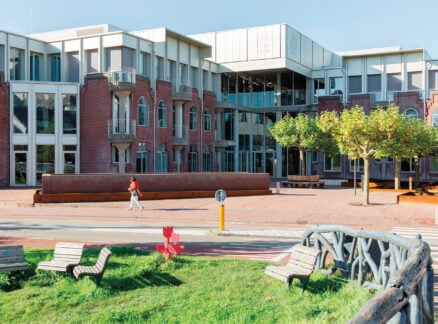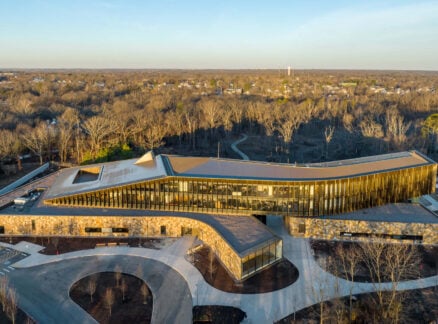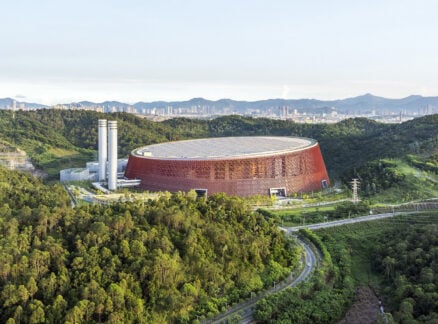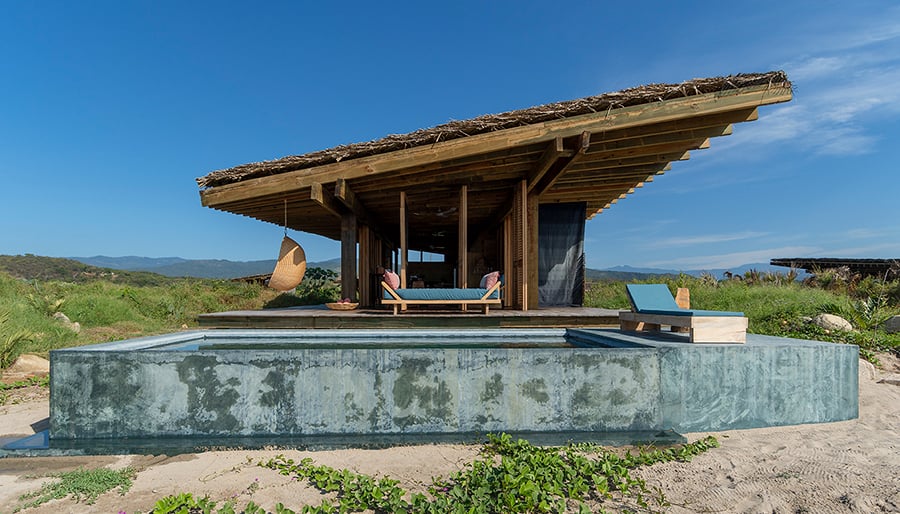
May 13, 2019
Outside Puerto Escondido in Oaxaca, Mexico, an Eco-Resort Balances Design and Nature
Mexican architect Alberto Kalach and environmental engineer Luis Urrutia restored around 22 acres of desolate beachfront, adding eco-villas that coexist with their natural surroundings.
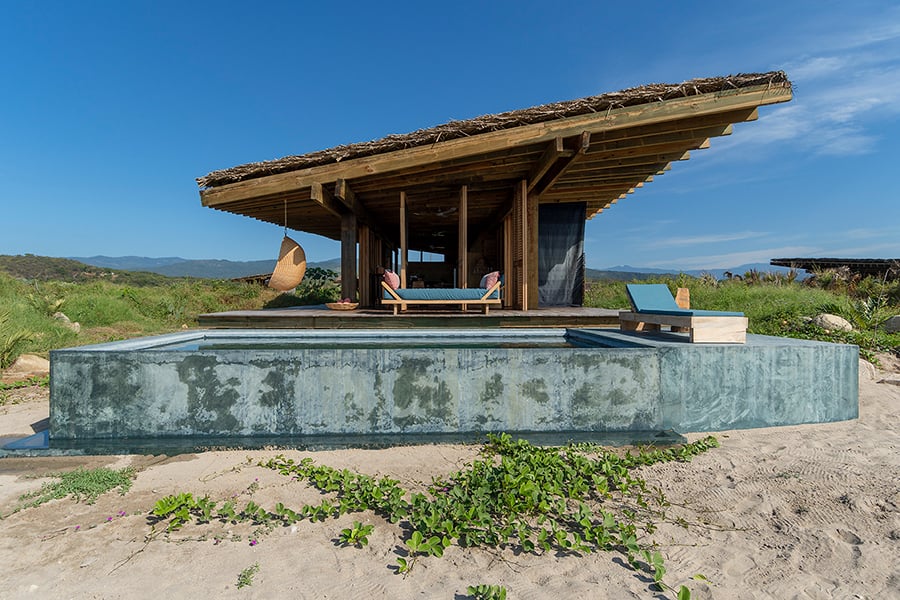
“Acacias, thevetias, mesquites, gliricidias, gumbo-limbos, lantana flowers”—celebrated Mexican architect Alberto Kalach is listing some of the native species that now occupy an ocean-front resort that’s located 30 minutes from the beachside town of Puerto Escondido in Oaxaca, Mexico. The approximately-22-acre site is verdant now, but the landscape was not always so fertile.
The area, formerly used for agriculture, sat barren and deserted until 2012. Sensing its potential, Luis Urrutia, an environmental engineer specializing in ecosystem restoration, invited Kalach to work with him on regenerating the area and, later, in 2017, build a series of eco-villas that could coexist with their natural surroundings. The result is Punta Pájaros, a masterful expression of design that works beautifully because, not in spite of, the landscape that envelops it.
“When we arrived there was no vegetation, save for the last vestiges of trees and plants that indicated the area was once part of a jungle,” explains Urrutia. With Kalach, he scouted the surrounding landscape for flora native to the region, and embarked on the task of reforesting the area with endemic species. It’s no secret that Kalach is as talented and enthusiastic a botanist as he is an architect: he oversaw the landscaping of the gardens for the neighboring art foundation Casa Wabi and his portfolio features a multitude of buildings and spaces that brim with barely-tamed greenery, including private homes, the office tower that harbors his own studio, and the Mexican capital’s monumental Vasconcelos Library. Following—perhaps unconsciously—in the footsteps of late Mexican architect Luis Barragán, Kalach’s approach to design and construction seems rooted in a devout admiration for nature.
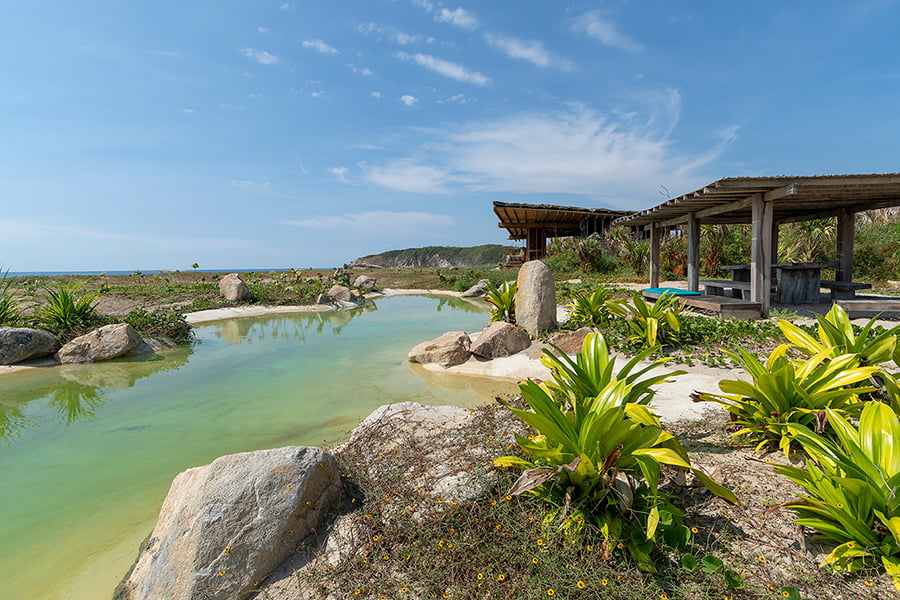
“I’m under the impression that these lands, like a great part of Mexican territory, were systematically deforested either due to ignorance or necessity,” laments Kalach. “Our strategy has been to plant trees and shrubbery that are native to the area—those that grow in sand and need little water—and then let nature take its course.”
Early on, the team decided to build on just ten percent of the site to protect the nascent jungle from the inevitable impacts of construction. Eight independent villas use local wood certified by Mexico’s environmental ministry, the Secretariat of Environment and Natural Resources (there’s pine for the structure, macuil for the floors, and tzalam for the doors). The structures also keep a low profile: “I designed the villas with a low height so that they could become hidden as soon as possible within the growing vegetation, maintaining the natural beauty of the place and providing a sense of privacy to the visitors,” Kalach explains. The villas’ program is simple. Inside, a kitchen, dining table, and living room face a terrace with a small, private pool and seemingly infinite view of the Pacific Ocean. A low wall divides the kitchen from the bedroom. To the side, a small bathroom is only partly enclosed, with most of it facing the surrounding landscape.
Besides aesthetics, Kalach’s team made a number of choices in the name of sustainability. Each structure rests atop thin wooden pilotis, a decision that was made to avoid interrupting the spread of flora and fauna that has begun across the terrain. The water used to irrigate the grounds is sourced from wells, though once the plants are fully grown, they will no longer rely on irrigation. Organic waste is sent to Casa Wabi’s compost area and used to fertilize the plants that are grown there, many of which are later placed in Punta Pájaros. Additionally, about 95 percent of the electricity used on the property comes from solar energy. The villas rely on natural ventilation to cool their interiors and are enveloped by screen doors that grant users panoramic views of their natural surroundings (wooden blinds also allow privacy).
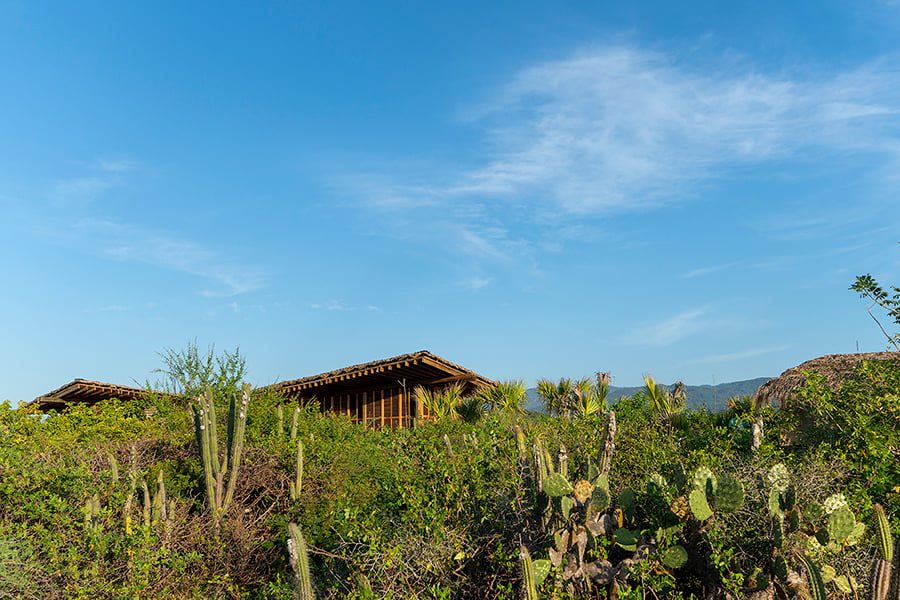
Providing visitors with a sense of seclusion and absolute immersion in nature was always the main intention behind Punta Pájaros. Throughout the design process, the team’s approach to nature bordered on reverence. “Our idea was to reconnect people with the environment,” says Urrutia. “Many visitors don’t understand what we’re doing at first because they’re accustomed to luxury hotel chains.” It’s true that Punta Pájaros is a far cry from the experience that other resorts offer, where nature is presented as a spectacle of sorts; an encounter that one can turn on and off at will. “Sometimes guests arrive here and they can’t sleep, because the noise from the ocean and the animals that now inhabit the vegetation is so intense. But after the second night they tell me, ‘Luis, this is the best sleep we’ve had in many years.’ That’s the effect we were after.”
In a country characterized by its natural wealth, the opposite of what Urrutia describes has become all too common: a remote, paradisiacal spot being discovered, developed, and ultimately devastated by a tourism sector eager to mine nature for profit. Cancún, Playa del Carmen, and most recently Tulum, are a few examples of places where the environmental effects of tourism have been disastrous. Often, architects are inherently complicit in the depletion of previously pristine landscapes, making the case of Punta Pájaros, as well as the work of Kalach and Urrutia, all the more admirable.
You may also enjoy “Lorcan O’Herlihy Architects Designs a Resilient Beachfront House in Malibu.”
Would you like to comment on this article? Send your thoughts to: [email protected]

















